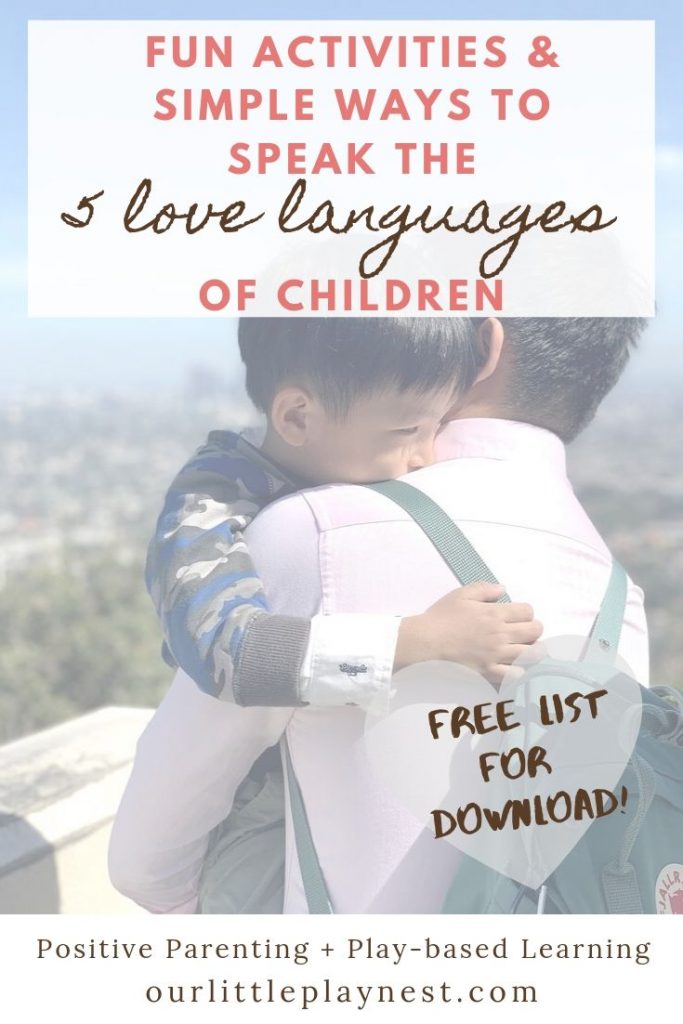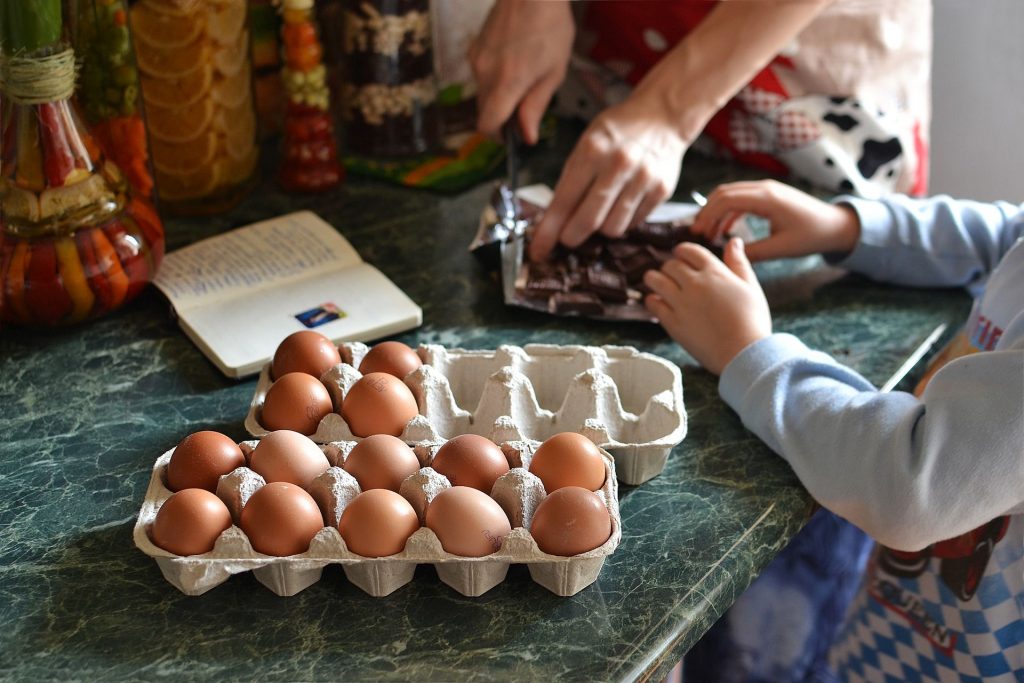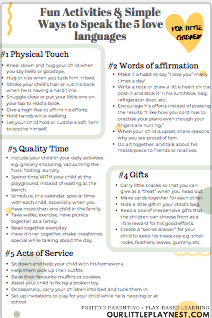As parents, we all love your children. But do our children feel our love? If you are not speaking your child’s love language, then he may not feel deeply connected with you.
I previously read Gary Chapman and Ross Campbell’s book on the 5 love languages, and I am surprised to know there is a children’s version: The 5 love languages of children.

What are the 5 love languages?
The focus of the book is on meeting your child’s need for love. I learned that every child has a special way of receiving love. Coined by Dr. Gary Chapman, the five ways that people speak and understand emotional love are:
Physical touch
Words of affirmation
Quality time
Gifts
Acts of Service
In this post, I will share some insights that I gained from reading the book. Read about the benefits when you speak your child’s love language and learn tips on how you can identify your child’s love language.
How to speak the five love languages to my little children?
At the end of the post, I have provided a free refrigerator sheet that summaries the fun and practical ideas for speaking each love language, specifically for little children. Hope this can be a visual reminder for you to connect with your child while conveying the feeling of love.
Disclaimer: These insights are by Dr. Chapman. I am sharing some notes from the book that I feel, will be useful for busy parents to read. This post is not a replacement for the book. If you need more clarity, I highly recommend that you read the book.
You can purchase this from the Goguru, official e-store for Times Pte Ltd.
Important points to note:
- When your child is under four years old, you are highly encouraged to speak all five languages. The five languages all converge to meet your child’s need for love.
- When your child is older, he may crave one language more than the other. Continue to speak all five languages even when he is above four years old, the reason is that he needs them to grow.
Love language #1: Physical touch
Physical touch is the easiest love language to speak because it’s free, and there is just no excuse not to touch your own kids.

ALL children need physical contact with their parents or caregivers throughout childhood and adolescence, even though its not their primary love language.
A hug communicates love to every child, but it SHOUTS “I love you” to children whose love language is physical touch.
Interesting findings:
- Some studies show that parents only touch their kids only when necessary (e.g. putting them in the car seat, dressing them). Many of them are unaware of how much their children need to be touched to have their emotional tanks filled!
- Physical touch is not just a hug or a kiss, but any kind of contact – a pat on the shoulder, holding your child’s hands, a little massage when he falls – these little actions send a big message to your child whose love language is physical touch.
- Some parents feel that physical affection may feminize a boy – this is not true. Keep your son’s emotional tank full and he will have healthy self-esteem and sexual identity.
- Unlike girls, boys may go through the affection-resistant stage. Other than hugs and kisses, you can jostle with your son, play wrestling, give high fives, play sports, touch him on his shoulder, etc.
More physical touch activity ideas in the summary sheet below.
Love language #2: Words of Affirmation
Other than giving words of affirmation, the tone of voice, gentleness of the mood and sense of caring all communicate emotional warmth and love.
Praise your child’s efforts instead of results. “You are a good girl!” is not as effective as “you have kept your shoes away neatly!”
Avoid random frequent praises as some children might assume it is natural – when you don’t give those praises, they might become anxious because they assume something is wrong.
If your child’s primary love language is words of affirmation, he will be hurt very deeply when the words he receives from you are negative, or when you yell and scream at him. Offer positive, loving verbal guidance instead of negative or shaming words.
Love language #3: Quality Time
Children who speak the quality time love language craves for your undivided attention. They need you to be fully present in order for their emotional love tank to be filled!

Quality time not only means doing things together, but it is also a way of knowing your child better. The more time you spend with your child, the more you converse and learn more about each other!
A good time to be with your child, according to Dr. Chapman, is just before bedtime. Make bedtime rituals warm, close and relaxed. Children enjoy sharing their feelings… reading a book at bedtime helps prevent life’s deepest problems down the road.
At my home:
Every night before we sleep, I will hug my kids as I read to them. And right after we switch off the lights, we will chat a little as they share the best things that happened to them that day. These moments are so precious!
Tip: If you find you it difficult to spend time with your children, schedule them into your calendar. Your children will appreciate the fact that you value your time with them. No matter how busy you are, make time for your kids.
Love language #4: Gifts

Do not confuse giving as a bribe or payment for services rendered. (e.g. giving your child a toy after he cleans his room is not a true gift, but a payment for his services.) Instead, a true gift is a genuine expression of love for your child.
You MUST fill up your child’s emotional tank first before the gift can communicate heartfelt love to your child.
Important notes:
- Make sure there are other love languages that are given along with the gift.
- Gifts should not be substituted for the other love languages. Avoid showering children with too many gifts.
- Be discerning when choosing gifts, especially toys.
- Gifts don’t have to come from a store. Special stones, seashells, leaves, a hand-made card are all possible gifts.
Love language #5: Acts of Service

As parents when we serve our children (e.g. cook their lunch, tidy their bags, etc), our main goal is not to make them happy, but to do what is best for them, to fill their love tanks.
Important notes:
- Acts of service should be used in conjunction with other love languages, just like love language #4, gifts.
- Never use acts of service to manipulate your children “if you don’t clean up the room, I will not cook for you tonight!”
- Never give in to demands for excessive gifts or services as children may become self-centred. Moderation is key.
- Acts of service can be a role model for your child’s service and responsibility. When they develop independence, they will know how to serve themselves and others.
What is my child’s love language?
As you try to discover your child’s primary love language, note that:
- It takes time to understand your child.
- Speak all 5 languages to your child under 4 years old. As your child grows older, he will learn how to receive and express love, and slowly specialize in a love language.
- When you speak their love language negatively, you will hurt your child very deeply.
- Love language can temporarily change, especially during adolescence.
How to discover your child’s primary love language?
1. Observe how your child expresses his love to you. (Best used for children age 5 to 10 years old)
“Mummy you look good in that dress! Mummy I love you so much! Thanks for helping me mum!” – likely words of affirmation
“Papa can I have a hug? Can you hold my hand?” – likely physical touch
“Dad can you help me fix this? I love my mummy because she cooks for me!” – likely acts of service
“Mom can we play together? Daddy let’s read!” – likely quality time
2. Observe how your child expresses his love to others

If your child likes to make gifts for his friends or teachers, his love language might likely be receiving gifts. (Of course, you cannot be the one suggesting that he should make gifts for his teachers, else this is not a valid clue to his love language.)
If your child loves to hugs his friends, physical touch might be his primary love language.
3. Listen to what your child requests most often.

All children crave for attention. Listen closely to the requests he made most often. If he receives love by quality time, you may expect to hear him make more requests about getting you to spend time with him, as compared to other requests like “Daddy I want to hold your hand!”
If he is making more requests like “Mum do you think I did well at the piano recital? Dad what do you think of my artwork?”, then he might likely be assured by words of affirmation.
4. Notice what your child most frequently complains about.
“You are always working. We haven’t played football in a while. You take care of the baby all day!” – likely requesting for quality time.
“I wish you can tell me about my ballet performance. Mummy do you love me?” – likely requesting for words of affirmation
5. Give your child a choice between two options.

“Should we play basketball or do you want me to help you buy your new books?” – quality time vs gifts
“Do you want me to make cupcakes for you or shall we have some juice together? ” – acts of service vs quality time
“I am going on a work trip. Do you want me to write you a postcard, or buy you a present?” – words of affirmation vs gifts
Make a conscious effort while giving options, and take notes of the choices your child makes.
6. Play a game “I like you because…”
Take turns to complete the sentence: “I like you because…”
Mom: “I like you because you read to your sister!”
Boy: “I like you because you send me to school!”
This is a fun way to learn about your child’s preferred way of receiving love. At the same time, you are also teaching him how to give words of affirmation to others!
What are the benefits of speaking your child’s love language?
- Speaking your child’s love language makes him feel loved. When he feels loved and has his emotional tank full, he will be more responsive to your parental guidance throughout his life. He will listen and cooperate without resentment.
- When you speak your child’s love language, you are teaching her how to love and serve others in different ways. We want our children to be giving and caring – and the best way is to role model.
- Speaking your child’s love language is an effective way to communicate emotional love. If your child’s love language is quality time, but you are constantly providing words of affirmation, he may not feel that you truly love him.
Be multilingual
Whatever your child’s primary love language may be, always speak all five languages to them.
Avoid the mistake of using one language and exclude others, particularly for gifts.
Our role is to nurture our kids with all five languages, so they will learn how to give and receive love to different people as they meet as they grow up.

Fun activities and simple ways to speak the five love languages – the little children edition (Free refrigerator sheet!)

Download the free summary sheet and spend some time connecting with your child. Make sure you speak all 5 love languages to your little ones!
There are many awesome articles about speaking our children’s love language. More resources and printables can be found in:
How to Connect with Your Child Using Love Languages by Big Life Journal
The Five Love Languages of Children by The Holly Effect
